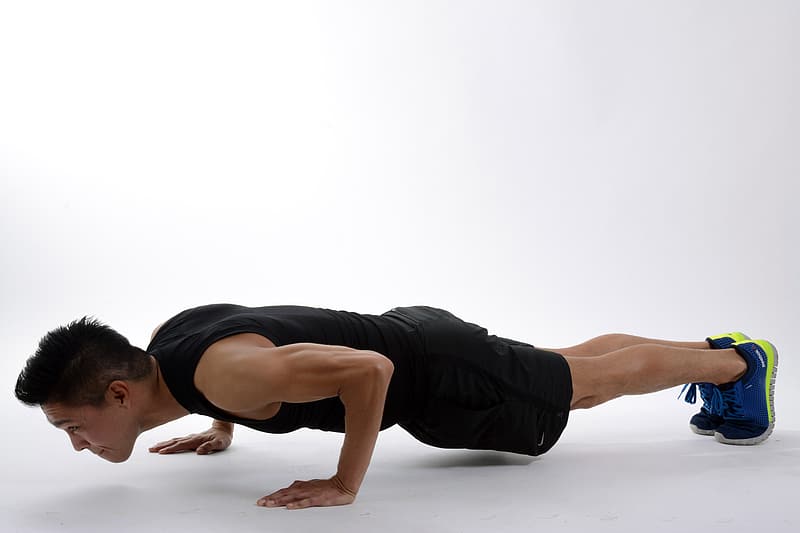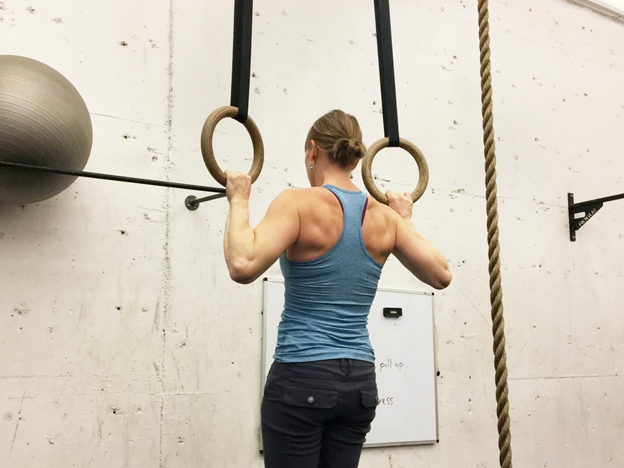What Can Bodyweight Strength Training Do For You?
July 29, 2020

By Madelyn Geier, an SIUE Senior Intern in Exercise Science
What is bodyweight strength training?
Bodyweight strength training is a style of exercise that uses the weight of your body as a source of resistance for various exercises. This training approach often targets multiple muscles per exercise and focuses on building muscular strength and stability through compound movements like push-ups, sit-ups, pull-ups, and squats. Bodyweight training generally doesn’t use any weights or machines, so it can be performed nearly anywhere that you have enough space to fit yourself. While external resistance isn't used, some individuals do, however, incorporate equipment such as pull-up bars, rings, or resistance bands to enhance certain bodyweight movements.
Why do bodyweight strength training?
Bodyweight strength training is advantageous for people of every age and ability level. The lack of equipment means that exercises can be tailored to the needs and space of the individual, ranging from very basic movements to more advanced, compound exercises. For some, basic bodyweight movements are a great place to start since they are generally very safe to perform and have low rates of injury. This means that individuals who do not have a background in fitness can use light bodyweight training to build a whole-body baseline of strength before moving into more advanced styles of strength training.
Bodyweight strength training is also great for those more experienced exercisers that want a greater challenge to their fitness routine, as nearly every movement can be modified and progressed to see consistent strength, mobility, and flexibility improvements. Advanced skills like performing front-levers and planches can take years of training but with consistency, you can reach the level of fitness to complete this movement with just your body.
Perhaps the biggest benefit to bodyweight exercises is that they often work several muscle groups at once. Exercises like the push-up, chin-up, and dip activate a variety of both large muscle groups and smaller stabilizers with every repetition. This means that bodyweight exercises are fantastic for building well-rounded whole-body strength (1).
This style of fitness is also able to be performed throughout the day in short intervals. An intense hour of weightlifting might leave you sore and exhausted for hours, but performing crunches or push-ups every 30 minutes over the course of a day, results in significant volume training spread out over the whole day. For example, try doing 5 push-ups every time you get up from your desk or doing a pull-up every time you walk past your doorframe.
How can I get started?
The push-up, chin-up/pull-up, and squat are often considered staple movements that can be included in a bodyweight strength training program. These exercises, as well as progressions and regressions of them, will be explained below.
The Push-up
The push-up is perhaps the most well-known bodyweight movement, and for good reason. This seemingly basic movement incorporates several muscle groups throughout the body and is excellent for both strength and stability training. The push-up primarily works your chest muscles and triceps due to its push-focused range of motion. Your deltoids will also get a heavy workout because they must support the movement of your arms. Additionally, your abdominal muscles are working hard to keep your core tight in order to maintain proper alignment between your upper and lower body.

In addition to working several muscle groups, the push-up is a convenient exercise because it can be done anywhere without any equipment. While some people may be intimidated by push-ups, there are several progressions and regressions of the push-up that allow it to be modified for any fitness level. For beginners, resting on your knees or performing push-ups at an incline reduces the amount of strength required because you are pushing up less of your total body weight off the ground.
As you progress, you can move on to traditional push-ups and work to perfect your form while increasing the number of sets and repetitions at this level. However, progressing into more advanced movements like pike push-ups, decline push-ups, diamond push-ups, and handstand push-ups will help you continue to build significant strength throughout your entire upper body (2).
The Chin-up and Pull-up
Chin-ups, and their slightly more difficult cousin the pull-up, are one of the best upper-body exercises that can be performed with just your bodyweight (3). The chin-up involves a palms-facing-you supinated grip on a straight bar, whereupon you pull your body upwards until your chin is level with the bar. The pull-up is a similar movement that uses a wider, pronated palms-facing-out grip. The reason that the pull-up is harder is because there is less bicep activation in the movement, meaning that your latissimus dorsi muscles are doing most of the work. Pull-up bars are often found in gyms, outdoor recreation areas, or are available for purchase and can be mounted from door frames in your own home.

These movements heavily involve the latissimus dorsi and biceps brachii, which means that training this movement will get you a strong back and strong biceps. A complex movement like this works your entire upper body, but with heavy assistance coming from the forearms, shoulders, and abdominal muscles. Chin-ups and pull-ups might seem difficult at first but have a variety of regressions for beginners. A negative chin-up/pull-up involves jumping up until your chin is already at the bar and then slowly lowering yourself down, performing the second half of the full range of motion. This backward version of the movement lets you activate all the same muscles as you build the strength to perform a controlled descent.
To build foundational strength in the muscles that will be essential for performing a chin-up or pull-up, one can start with a dead hang. This involves hanging from a bar with your arms completely straight, and your back and shoulders activated so that you are “actively” hanging with your muscles engaged, not just dangling from your shoulder sockets.
Another way for people of any strength level to start performing chin-ups and pull-ups is with the assistance of resistance bands. This ventures outside the realm of “bodyweight only” workouts, but a band with ample resistance can allow you to perform the full range of motion by reducing the overall load being raised. This method will activate and strengthen your muscles until you are strong enough to do the exercise without assistance. While this exercise can be daunting to a beginner, with enough consistency anyone can build up the strength to perform pull-ups!
Squats
Squats are a powerful movement for building lower-body strength and flexibility. While squats are considered a bodyweight exercise because they do not need any equipment, weights, or resistance bands can be added if desired. The main muscles worked by squats are your big leg muscles: quadriceps, gluteus maximus, hamstrings, and your hip adductors. The stabilization required also heavily works your core muscles, particularly the obliques.
Squats are extremely beneficial when performed in the full range of motion but can also be performed isometrically. An isometric squat requires holding the “bottom” portion of the squat movement, with your thighs parallel to the ground. This works all the squat muscles to a greater degree the longer you hold it. Once you are comfortable with the basic squat and have built up enough strength and balance, you can begin doing single-leg squats. This advanced movement places your entire body weight on a single leg, which makes it excellent for developing strength and stability. If you are interested in building a strong foundation of functional strength, as well as improving your hip and lower body mobility, the squat is one of the best exercises to include in your routine (4).
Additional Considerations
There are countless free bodyweight exercise guides available on the internet, making it certain that you can find one that matches your personal fitness goals. It is important to note that selecting a program is only half the battle; rest, recovery, and diet are also extremely important for building muscle, strengthening your body, and preventing injury. For most people, it’s generally a good idea to give each muscle group at least 24-48 hours of rest after working it to allow the muscle time to repair and strengthen itself (5). Adequate protein and caloric intake are also critical for strengthening your muscles. A good night's sleep of 6-8 hours will give your body time to rest, repair, and rejuvenate for another training session (6).
Bodyweight strength training is an efficient, effective, and affordable way for people of all fitness and ability levels to build strength, stability, and flexibility. The intensity of your training depends on your personal goals but adding any amount of regular strength training to your life will improve your ability to do basic things like garden, carry groceries, move furniture, and perform your day-to-day tasks without injuring yourself. With practically no barrier to entry, bodyweight strength training can be tailored to your needs and goals so that you can live a stronger and healthier life.
References
- Harrison, J. S. (2010). Bodyweight Training: A return to basics. Strength and Conditioning Journal, 32(2), 52-55. https://doi.org/10.1519/ssc.0b013e3181d5575c
- Kim, Y., Kim, D., & Ha, M. (2016). Effect of the push-up exercise at different palmar width on muscle activities. Journal of Physical Therapy Science, 28(2), 446-449. https://doi.org/10.1589/jpts.28.446
- Ronai, P., & Scibek, E. (2014). The Pull-up. Strength and Conditioning Journal, 36(3), 88-90. https://doi.org/10.1519/ssc.0000000000000052
- Myer, G. D., Kushner, A. M., Brent, J. L., Schoenfeld, B. J., Hugentobler, J., Lloyd, R. S., . . . Mcgill, S. M. (2014). The back squat. Strength and Conditioning Journal, 36(6), 4-27. https://doi.org/10.1519/ssc.0000000000000103
- Ahtiainen, J. P., Lehti, M., Hulmi, J. J., Kraemer, W. J., Alen, M., Nyman, K., . . . Häkkinen, K. (2011). Recovery after heavy resistance exercise and skeletal muscle androgen receptor and insulin-like growth factor-I Isoform expression in strength trained men. Journal of Strength and Conditioning Research, 25(3), 767-777. https://doi.org/10.1519/jsc.0b013e318202e449
- Dattilo, M., Antunes, H., Medeiros, A., Neto, M. M., Souza, H., Tufik, S., & Mello, M. D. (2011). Sleep and muscle recovery: Endocrinological and molecular basis for a new and promising hypothesis. Medical Hypotheses, 77(2), 220-222. https://doi.org/10.1016/j.mehy.2011.04.017
Categories: All Categories, strength training, bodyweight training, internships, exercise













